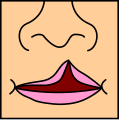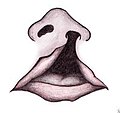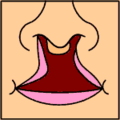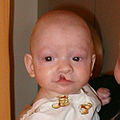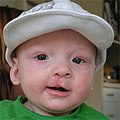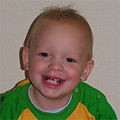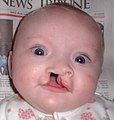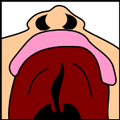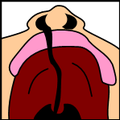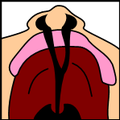Cleft lip and cleft palate: Difference between revisions
| Line 27: | Line 27: | ||
<gallery> |
<gallery> |
||
image:CleftLip1.svg|Unilateral incomplete |
image:CleftLip1.svg|Unilateral incomplete |
||
Image: |
Image:Unlitrtasl.jpg|Unilateral complete |
||
image:CleftLip3.png|Bilateral complete |
image:CleftLip3.png|Bilateral complete |
||
</gallery> |
</gallery> |
||
Revision as of 19:17, 8 May 2008
| Cleft lip and cleft palate | |
|---|---|
| Specialty | Medical genetics |
Cleft lip and cleft palate, which can also occur together as cleft lip and palate are variations of a type of clefting congenital deformity caused by abnormal facial development during gestation. This type of deformity is sometimes referred to as a cleft. A cleft is a sub-division in the body's natural structure, regularly formed before birth. A cleft lip or palate can be successfully treated with surgery soon after birth. Cleft lips or palates occur in somewhere between one in 600-800 births.
The term harelip is no longer used, and is considered extremely offensive. The Chinese word for cleft lip is tuchun (兔唇), literally "harelip."
Cleft lip
If only skin tissue is affected one speaks of cleft lip. Cleft lip is formed in the top of the lip as either a small gap or an indentation in the lip (partial or incomplete cleft) or continues into the nose (complete cleft). Lip cleft can occur as one sided (unilateral) or two sided (bilateral). It is due to the failure of fusion of the maxillary and medial nasal processes (formation of the primary palate).
-
Unilateral incomplete
-
Unilateral complete
-
Bilateral complete
A mild form of a cleft lip is a microform cleft. A microform cleft can appear as small as a little dent in the red part of the lip or look like a scar from the lip up to the nostril. In some cases muscle tissue in the lip underneath the scar is affected and might require reconstructive surgery. It is advised to have newborn infants with a microform cleft checked with a craniofacial team as soon as possible to determine the severeness of the cleft. The actor Joaquin Phoenix is an example of a person with a microform cleft that did not require surgery.
-
3 months old boy before going into surgery to have his unilateral incomplete cleft lip repaired.
-
The same boy, 1 month after the surgery.
-
Again the same boy, age 1.5 years old. Note how the scar gets less visible with age.
-
6 month old girl before going into surgery to have her unilateral incomplete cleft lip repaired.
-
The same girl, 1 month after the surgery.
-
Again the same girl, age 5.4 years old. Note how the scar gets less visible with age.
The complete restoration of this Cleft Child girl from above can be seen here. http://www.pbase.com/stella97king/cleft_lip
Cleft palate
Cleft palate is a condition in which the two plates of the skull that form the hard palate (roof of the mouth) are not completely joined. The soft palate is in these cases cleft as well. In most cases, cleft lip is also present. Cleft palate occurs in about one in 700 live births worldwide.[1]
Palate cleft can occur as complete (soft and hard palate, possibly including a gap in the jaw) or incomplete (a 'hole' in the roof of the mouth, usually as a cleft soft palate). When cleft palate occurs, the uvula is usually split.It occurs due to the failure of fusion of the lateral palatine processes, the nasal septum, and/or the median palatine processes (formation of the secondary palate).
The hole in the roof of the mouth caused by a cleft connects the mouth directly to the nasal cavity.
Note: the next images show the roof of the mouth. The top shows the nose, the lips are colored pink. For clarity the images depict a toothless infant.
-
Incomplete cleft palate
-
Unilateral complete lip and palate
-
Bilateral complete lip and palate
A direct result of an open connection between the oral cavity and nasal cavity is velopharyngeal insufficiency (VPI). Because of the gap, air leaks into the nasal cavity resulting in a hypernasal voice resonance and nasal emissions.[2] Secondary effects of VPI include speech articulation errors (e.g., distortions, substitutions, and omissions) and compensatory misarticulations (e.g., glottal stops and posterior nasal fricatives).[3]. Possible treatment options include speech therapy, prosthetics, augmentation of the posterior pharyngeal wall, lengthening of the palate, and surgical procedures.[2]
Prevalence among racial groups
Prevalence rates reported for live births for Cleft lip with or without Cleft Palate (CL +/- P) and Cleft Palate alone (CPO) varies within different racial groups.
The highest prevalence rates for (CL +/- P) are reported for Native Americans and Asians. Africans have the lowest prevalence rates.[citation needed]
- Native Americans: 3.74/1000
- Japanese: 0.82/1000 to 3.36/1000
- Chinese: 1.45/1000 to 4.04/1000
- Caucasians: 1.43/1000 to 1.86/1000
- Latin Americans: 1.04/1000
- Africans: 0.18/1000 to 1.67/1000
Rate of occurrence of CPO is similar for Caucasians, Africans, North American natives and Asians.
Prevalence of "cleft uvula" has varied from .02% to 18.8% with the highest numbers found among Chippewa and Navajo and the lowest generally in Africans.[citation needed]
Causes of cleft
During the first six to eight weeks of pregnancy, the shape of the embryo's head is formed. Five primitive tissue lobes grow:
- a) one from the top of the head down towards the future upper lip;
- b-c) two from the cheeks, which meet the first lobe to form the upper lip;
- d-e) and just below, two additional lobes grow from each side, which form the chin and lower lip;
If these tissues fail to meet, a gap appears where the tissues should have joined (fused). This may happen in any single joining site, or simultaneously in several or all of them. The resulting birth defect reflects the locations and severity of individual fusion failures (e.g., from a small lip or palate fissure up to a completely malformed face).
The upper lip is formed earlier than the palate, from the first three lobes named a to c above. Formation of the palate is the last step in joining the five embryonic facial lobes, and involves the back portions of the lobes b and c. These back portions are called palatal shelves, which grow towards each other until they fuse in the middle.[4] This process is very vulnerable to multiple toxic substances, environmental pollutants, and nutritional imbalance. The biologic mechanisms of mutual recognition of the two shelves, and the way they are glued together, are quite complex and obscure despite intensive scientific research.[5]
The cause of cleft lip and cleft palate formation can be genetic in nature. A specific gene that increases threefold the occurrence of these deformities has been identified by Zucchero et al in 2004[6]
as reported by the BBC.[7]
Environmental influences may also cause, or interact with genetics to produce, orofacial clefting. Scientists have investigated seasonal causes (such as pesticide exposure); maternal diet and vitamin intake; retinoids- which are members of the vitamin A family; anticonvulsant drugs; alcohol; cigarette use; nitrate compounds; organic solvents; parental exposure to lead; and illegal drugs (cocaine, crack cocaine, heroin, etc.) as teratogens that increase the possibility of clefting.
If a person is born with a cleft, the chances of that person having a child with a cleft, given no other obvious factor, rises to 1 in 14. Research continues to investigate the extent to which Folic acid can reduce the incidence of clefting.
In some cases, cleft palate is caused by syndromes which also cause other problems. Stickler's Syndrome can cause cleft lip and palate, joint pain, and myopia. Loeys-Dietz syndrome can cause cleft palate or bifid uvula, hypertelorism, and aortic aneurysm. Cleft lip/palate may be present in Patau’s Syndrome (trisomy 13). Many clefts run in families, even though there does not seem to be any identifiable syndrome present.
Treatment
Cleft lip and palate is very treatable, however the kind of treatment depends on the type and severity of the cleft. Most children with a form of clefting are monitored by a cleft palate team or craniofacial team through young adulthood. Care can be lifelong. Treatment procedures can vary between craniofacial teams. For example, some teams wait on jaw correction until the child is aged 10 to 12 (argument: growth is less influential as deciduous teeth are replaced by permanent teeth, thus saving the child from repeated corrective surgeries), while other teams correct the jaw earlier (argument: less speech therapy is needed than at a later age when speech therapy becomes harder). Within teams, treatment can differ between individual cases depending on the type and severity of the cleft.
Cleft lip treatment
Within the first 2-3 months after birth, surgery is performed to close the cleft lip. While surgery to repair a cleft lip can be performed soon after birth, the often preferred age is at approximately 10 weeks of age, following the "rule of 10s" coined by surgeons Wilhelmmesen and Musgrave in 1969 (the child is at least 10 weeks of age; weighs at least 10 pounds, and has at least 10 g haemoglobin). If the cleft is bilateral and extensive, two surgeries may be required to close the cleft, one side first, and the second side a few weeks later. The most common procedure to repair a cleft lip is the Millard procedure pioneered by Ralph Millard.
Often an incomplete cleft lip requires the same surgery as complete cleft. This is done for two reasons. Firstly the group of muscles required to purse the lips run through the upper lip. In order to restore the complete group a full incision must be made. Secondly, to create a less obvious scar the surgeon tries to line up the scar with the natural lines in the upper lip (such as the edges of the philtrum) and tuck away stitches as far up the nose as possible. Incomplete cleft gives the surgeon more tissue to work with, creating a more supple and natural-looking upper lip.
D. Ralph Millard pioneered the technique of rotation-advancement procedure for cleft lip repair, performing the first procedure at a Mobile Army Surgical Hospital unit in Korea.[8] This technique is the standard used to repair unilateral cleft lip all over the world.
Cleft palate treatment

Often a cleft palate is temporarily closed using a palatal obturator. The obturator is a prosthetic device made to fit the roof of the mouth covering the gap.
Cleft palate can also be corrected by surgery, usually performed between 9 and 18 months. Approximately 20-25% only require one palatal surgery to achieve a competent velopharyngeal valve capable of producing normal, non-hypernasal speech. However, combinations of surgical methods and repeated surgeries are often necessary as the child grows. One of the new innovations of cleft lip and cleft palate repair is the Latham appliance. The Latham is surgically inserted by use of pins during the child's 4th or 5th month. After it is in place, the doctor, or parents, turn a screw daily to bring the cleft together to assist with future lip and/or palate repair.
If the cleft extends into the maxillary alveolar ridge, the gap is usually corrected by filling the gap with bone tissue. The bone tissue can be acquired from the patients own chin, rib or hip.
Speech and hearing treatments
A tympanostomy tube is often inserted into the eardrum to aerate the middle ear. This is often beneficial for the hearing ability of the child. Speech problems are usually treated by a speech-language pathologist. In some cases pharyngeal flap surgery is performed to regulate the airflow during speech and reduce nasal sounds.
Sample treatment schedule
Note that each individual patient's schedule is treated on a case-by-case basis and can vary per hospital. The table below shows a common sample treatment schedule. The colored squares indicate the average timeframe in which the indicated procedure occurs. In some cases this is usually one procedure (for example lip repair) in other cases this it is an ongoing therapy (for example speech therapy).
age |
||||||||||||||||||||||
| Palatal obturator | ||||||||||||||||||||||
| Repair cleft lip | ||||||||||||||||||||||
| Repair soft palate | ||||||||||||||||||||||
| Repair hard palate | ||||||||||||||||||||||
| Tympanostomy tube | ||||||||||||||||||||||
| Speech therapy/Pharyngeal surgery | ||||||||||||||||||||||
| Bone grafting jaw | ||||||||||||||||||||||
| Orthodontics | ||||||||||||||||||||||
| Further cosmetic corrections |
Craniofacial team
A craniofacial team is routinely used to treat this condition. The majority of hospitals still use craniofacial teams; yet others are making a shift towards dedicated cleft lip and palate programs. While craniofacial teams are widely knowledgeable about all aspects of craniofacial conditions, dedicated cleft lip and palate teams are able to dedicate many of their efforts to being on the cutting edge of new advances in cleft lip and palate care.
Many of the top pediatric hospitals are developing their own CLP clinics in order to provide patients with comprehensive multi-disciplinary care from birth through adolescence. Allowing an entire team to care for a child throughout their cleft lip and palate treatment (which is ongoing) allows for the best outcomes in every aspect of a child's care. While the individual approach can yield significant results, current trends indicate that team based care leads to better outcomes for CLP patients. .[9]
A complete listing of craniofacial teams is available through the Cleft Palate Foundation
Complications

Cleft may cause problems with feeding, ear disease, speech and socialization.
Due to lack of suction, an infant with a cleft may have trouble feeding. An infant with a cleft palate will have greater success feeding in a more upright position. Gravity will help prevent milk from coming through the baby's nose if he/she has cleft palate. Gravity feeding can be accomplished by using specialized equipment, such as the Haberman Feeder, or by using a combination of nipples and bottle inserts commonly used with other infants. A large hole, crosscut, or slit in the nipple, a protruding nipple and pressure applied to the bottle insert by the caregiver's hand can result in controllable flow to the infant without the stigma caused by specialized equipment.
Individuals with cleft also face many middle ear infections which can eventually lead to total hearing loss. The eustacian tubes and external ear canals may be angled or tortuous, leading to food or other contamination of a part of the body that is normally self cleaning.
Because the lips and palate are both used in pronunciation, individuals with cleft usually need the aid of a speech therapist. Bonding with the infant, socializing with family and community may be interrupted by the unexpected appearance, unusual speech and the surgical interventions necessary. Support for the parents as well as for the child can be pivotal.(see Psychosocial issues)
Psychosocial issues
Having a cleft palate does not inevitably lead to a psychosocial problem. Most children who have their cleft lips repaired early have a happy youth and a healthy social life. However, it is important to remember that adolescents with cleft palate are at an elevated risk for developing psychosocial problems especially those relating to self concept, peer relationships, and appearance. It is important for parents to be aware of the psychosocial challenges their adolescents may face and to know where to turn if problems arise.
A cleft palate may impact an individual’s self-esteem, social skills, and behavior. There is a large amount of research dedicated to the psychosocial development of individuals with cleft palate. Self-concept may be adversely affected by the presence of a cleft palate. Research has shown that during the early preschool years (ages 3-5), children with cleft palate tend to have a self-concept that is similar to their peers without a cleft. However, as they grow older and their social interactions with other children increase, children with clefts tend to report more dissatisfaction with peer relationships and higher levels of social anxiety. Experts conclude that this is probably due to the associated stigma of visible deformities and speech abnormalities, if present. Children who are judged as attractive tend to be perceived as more intelligent, exhibit more positive social behaviors, and are treated more positively than children with cleft palate.[10] Children with clefts tend to report feelings of anger, sadness, fear, and alienation from their peers. Yet these children were similar to their peers in regard to "how well they liked themselves."
The relationship between parental attitudes and a child’s self-concept is crucial during the preschool years. It has been reported that elevated stress levels in mothers correlated with reduced social skills in their children.[11] Strong parent support networks may help to prevent the development of negative self-concept in children with cleft palate. In the later preschool and early elementary years, the development of social skills is no longer only impacted by parental attitudes but is beginning to be shaped by their peers. A cleft palate may affect the behavior of preschoolers. Experts suggest that parents discuss with their children ways to handle negative social situations related to their cleft palate. A child who is entering school should learn the proper (and age-appropriate) terms related to the cleft. The ability to confidently explain the condition to others may limit feelings of awkwardness and embarrassment and reduce negative social experiences.[12]
As children reach adolescence, the period of time between age 13 and 19, the dynamics of the parent-child relationship change as peer groups are now the focus of attention. An adolescent with cleft palate will deal with the typical challenges faced by most of their peers including issues related to self esteem, dating, and social acceptance.[13][14][15] Adolescents, however, view appearance as the most important characteristic above intelligence and humor.[16] This being the case, adolescents are susceptible to additional problems because they cannot hide their facial differences from their peers. Males typically deal with issues relating to withdrawal, attention, thought, and internalizing problems and may possibly develop anxiousness-depression and aggressive behaviors.[15] Females are more likely to develop problems relating to self concept and appearance. Individuals with cleft palate often deal with threats to their Quality of life for multiple reasons including: unsuccessful social relationships, deviance in social appearance, and multiple surgeries. Individuals with cleft palate often have lower QOL scores than their peers. Psychosocial functioning of individuals with cleft palate often improves after surgery, but does not last due to unrealistic expectations of surgery.
Controversy
In some countries cleft lip or palate deformities are considered reasons (either generally tolerated or officially sanctioned) to perform abortion beyond the legal fetal age limit, even though the fetus is not in jeopardy of life or limb. Some human rights activists contend this practice of "cosmetic murder" amounts to eugenics. A British clergywoman, Joanna Jepson, who suffered from a congenital jaw deformity herself (not a cleft lip or palate as is sometimes reported), has started legal action to stop the practice in the UK as reported by CNN[17] and the BBC.[18] Note that in the UK, an abortion could never be justified under the 1967 Abortion Act on the basis that a cleft lip and palate is not considered a serious handicap.
Famous people born with a cleft
Historical
| Name | Comments | Reference |
|---|---|---|
| Tutankhamen | Egyptian Pharaoh who may have had a slightly cleft palate according to diagnostic imaging | [19] |
| Doc Holliday | Dentist, gambler and gunfighter of the American Old West frontier | |
| Tad Lincoln | Fourth and youngest son of President Abraham Lincoln | [20] |
| Thomas Malthus | 18th and 19th Century English demographer and political economist |
Modern
| Name | Comments | Reference |
|---|---|---|
| Carmit Bachar | American dancer and singer | [21][22] |
| Eric Edgar Cooke | Australian criminal, the last person to be hanged in Western Australia | |
| Jürgen Habermas | German philosopher and sociologist | |
| Wendy Harmer | Australian comedian | |
| Richard Hawley | English guitarist, singer, songwriter and producer | |
| Michael Helm | Canadian novelist | |
| Jesse Jackson | American politician, professional civil rights activist and Baptist minister | |
| Stacy Keach | American actor and narrator | [23] |
| Tim Lott | English novelist | |
| Rita MacNeil | Canadian country and folk singer | |
| Cheech Marin | American actor and comedian | |
| Ljubo Milicevic | Australian football (soccer) player | |
| Nikki Payne | Canadian comedian and actress | |
| Geoff Plant | Canadian lawyer and politician, Attorney-General of British Columbia | |
| Lee Raymond | American business executive - former CEO and Chairman of ExxonMobil | |
| Louis Wain | English artist, best known for his drawings featuring anthropomorphised large-eyed cats[24] |
The popular belief that Joaquin Phoenix has a repaired cleft lip is mistaken. The mark on his lip is a microform, an almost-cleft that healed itself in utero. If the tissues join up just enough to create correct bone and muscle tissues, no corrective surgery is required, as was the case with Phoenix.
Fictional
In the Thomas Harris novel Red Dragon, the future serial killer Francis Dolarhyde is born with a cleft palate to a poor St. Louis, Missouri family that can't afford proper surgical repair. As an adult, he visits Hong Kong, where a dentist constructs corrective dentures: a normal set, which allows him to eat and speak like other people; and an abnormal set, which he uses to bite his victims in gruesome ways.
One of the most important characters in Par Lagerkvist's 1951 novel, Barabbas, is the "girl with a hare-lip" who is among the book's main representatives of belief in the new Christianity which the novel ambiguously explores. The Savior is one of the only people she has ever met who was able to understand her slurred speech. She witnesses for him and may have had a sexual relationship with Barabbas. Midway through the novel, during persecutions of Christians, she is stoned to death.
In J.M. Coetzee's "Life and Times of Michael K", the titular character is born with a cleft lip. Coetzee writes that the character's "lip curled like a snail's foot, the left nostril gaped".
In the swedish film 'The Simple-Minded Murder' the main character Sven, played by Stellan Skarsgård, is clef palate. This makes it hard for him to speak and therefore people takes him for an idiot.
Cleft lip and palate in animals
Cleft lips and palates are occasionally seen in cattle and dogs, and rarely in sheep, cats, horses, pandas and ferrets. Most commonly, the defect involves the lip, rhinarium, and premaxilla. Clefts of the hard and soft palate are sometimes seen with a cleft lip. The cause is usually hereditary. Brachycephalic dogs such as Boxers and Boston Terriers are most commonly affected.[25] An inherited disorder with incomplete penetrance has also been suggested in Shih tzus, Swiss Sheepdogs, Bulldogs, and Pointers.[26] In horses, it is a rare condition usually involving the caudal soft palate.[27] In Charolais cattle, clefts are seen in combination with arthrogryposis, which is inherited as an autosomal recessive trait. It is also inherited as an autosomal recessive trait in Texel sheep. Other contributing factors may include maternal nutritional deficiencies, exposure in utero to viral infections, trauma, drugs, or chemicals, or ingestion of toxins by the mother, such as certain lupines by cattle during the second or third month of gestation.[28] The use of corticosteroids during pregnancy in dogs and the ingestion of Veratrum californicum by pregnant sheep have also been associated with cleft formation.[29]
Difficulty with nursing is the most common problem associated with clefts, but aspiration pneumonia, regurgitation, and malnutrition are often seen with cleft palate and is a common cause of death. Providing nutrition through a feeding tube is often necessary, but corrective surgery in dogs can be done by the age of twelve weeks.[25] For cleft palate, there is a high rate of surgical failure resulting in repeated surgeries.[30] Surgical techniques for cleft palate in dogs include prosthesis, mucosal flaps, and microvascular free flaps.[31] Affected animals should not be bred due to the hereditary nature of this condition.
-
Cleft lip in a Boxer
-
Cleft lip in a Boxer with premaxillary involvement
-
Same dog as picture on left, one year later
References
- ^ "Statistics by country for cleft palate". WrongDiagnosis.com. Retrieved 2007-04-24.
- ^ a b Sloan GM (2000). "Posterior pharyngeal flap and sphincter pharyngoplasty: the state of the art". Cleft Palate Craniofac. J. 37 (2): 112–22. PMID 10749049.
- ^ Hill, J.S. (2001). Velopharyngeal insufficiency: An update on diagnostic and surgical techniques. Current Opinion in Otolaryngology and Head and Neck Surgery, 9, 365-368.
- ^ Dudas et al. (2007): Palatal fusion – Where do the midline cells go? A review on cleft palate, a major human birth defect. Acta Histochemica, Volume 109, Issue 1, 1 March 2007, Pages 1-14
- ^ Dudas M, Li WY, Kim J, Yang A, Kaartinen V (2007). "Palatal fusion - where do the midline cells go? A review on cleft palate, a major human birth defect". Acta Histochem. 109 (1): 1–14. doi:10.1016/j.acthis.2006.05.009. PMID 16962647.
{{cite journal}}: CS1 maint: multiple names: authors list (link) - ^ Zucchero, T.M. et al 2004 Interferon Regulatory Factor 6 (IRF6) Gene Variants and the Risk of Isolated Cleft Lip or Palate New England Journal of Medicine 351:769-780 [1]
- ^ "BBC NEWS". Retrieved 2007-07-01.
{{cite web}}: Text "Cleft palate genetic clue found" ignored (help); Text "Health" ignored (help) - ^ "Biography and Personal Archive". Retrieved 2007-07-01. at miami.edu
- ^ Joanne Green. "The Importance of a Multi-Disciplinary Approach". Retrieved 2007-10-15.
- ^ Tobiasen, J.M. (1984) Psychosocial correlated of congenital facial clefts: a conceptualization and model. Cleft Palate Journal, 21, 131-139.
- ^ Pope AW, Ward J (1997). "Self-perceived facial appearance and psychosocial adjustment in preadolescents with craniofacial anomalies". Cleft Palate Craniofac. J. 34 (5): 396–401. PMID 9345606.
- ^ "Cleft Palate Foundation". Retrieved 2007-07-01.
- ^ Snyder HT, Bilboul MJ, Pope AW (2005). "Psychosocial adjustment in adolescents with craniofacial anomalies: a comparison of parent and self-reports". Cleft Palate Craniofac. J. 42 (5): 548–55. doi:10.1597/04-078R.1. PMID 16149838.
{{cite journal}}: CS1 maint: multiple names: authors list (link) - ^ Endriga MC, Kapp-Simon KA (1999). "Psychological issues in craniofacial care: state of the art". Cleft Palate Craniofac. J. 36 (1): 3–11. PMID 10067755.
- ^ a b Pope, A.W. & Snyder, H.T. (2004). Psychosocial adjustment in children and adolescents with a craniofacial anomaly: Age and sex patterns. The Cleft Palate-Craniofacial Journal, 42, 4.
- ^ Prokohorov, A.V., Perry, C.L., Kelder, S.H., & Klepp, K.I. (1993). Lifestyle values of adolescents: Results from the Minnesota Heart Health Youth Program. Adolescence, 28.
- ^ "CNN.com - Priest challenges late abortion - Dec. 1, 2003". Retrieved 2007-07-01.
- ^ "BBC NEWS". Retrieved 2007-07-01.
{{cite web}}: Text "CPS examines late abortion case" ignored (help); Text "England" ignored (help); Text "Hereford/Worcs" ignored (help) - ^ "King Tut Not Murdered Violently, CT Scans Show". Retrieved 2007-07-01.
- ^ "HistoryBuff.com -- Tad Lincoln: The Not-so-Famous Son of A Most-Famous President". Retrieved 2007-07-01.
- ^ "Carmit Bachar, smile ambassador". Retrieved 2007-10-13.
- ^ Beverley Lyons, October 16, 2006. Carmite Doing Her Bit For Charity. The Daily Record
- ^ "Stacy Keach". Retrieved 2007-07-01.
{{cite web}}: Text "Cleft Palate Foundation" ignored (help) - ^ Louis Wain was famous for his amusing drawings of cats and kittens in human situations: possibly when he was a child he may have compared his own mouth to that of a cat which has a natural cleft, drawing the animals to mock his deformity
- ^ a b Ettinger, Stephen J.;Feldman, Edward C. (1995). Textbook of Veterinary Internal Medicine (4th ed. ed.). W.B. Saunders Company. ISBN 0-7216-6795-3.
{{cite book}}:|edition=has extra text (help)CS1 maint: multiple names: authors list (link) - ^ Garcia, J.F. Rodriguez (2006). "Surgery of the Soft and Hard Palate". Proceedings of the North American Veterinary Conference. Retrieved 2007-04-28.
- ^ Semevolos, Stacy A. (1998). "Surgical Repair of Congenital Cleft Palate in Horses: Eight Cases (1979–1997)" (PDF). Proceedings of the American Association of Equine Practitioners. Retrieved 2007-04-28.
{{cite web}}: Unknown parameter|coauthors=ignored (|author=suggested) (help) - ^ "Mouth". The Merck Veterinary Manual. 2006. Retrieved 2007-04-28.
- ^ Beasley, V. (1999). "Teratogenic Agents". Veterinary Toxicology. Retrieved 2007-04-28.
- ^ Lee J, Kim Y, Kim M, Lee J, Choi J, Yeom D, Park J, Hong S (2006). "Application of a temporary palatal prosthesis in a puppy suffering from cleft palate". J. Vet. Sci. 7 (1): 93–5. PMID 16434860.
{{cite journal}}: CS1 maint: multiple names: authors list (link) - ^ Griffiths L, Sullivan M (2001). "Bilateral overlapping mucosal single-pedicle flaps for correction of soft palate defects". Journal of the American Animal Hospital Association. 37 (2): 183–6. PMID 11300527.
31. ^ Stella King Cleft Child; http://www.pbase.com/stella97king/cleft_lip
See also
Treatment/aids
- Oral and Maxillofacial Surgery
- Haberman Feeder
- Palatal obturator
- Vomer flap surgery
- The Latham Device http://www.pbase.com/stella97king/cleft_lip&page=2]]
Syndromes
General Support Discussion Boards
- cleftAdvocate's Family-to-Family Connection Listserv
- aboutcleft - International Discussion Boards
- Face Forward - The UK's Number One Discussion Boards

